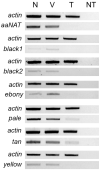RNAi-Mediated Manipulation of Cuticle Coloration Genes in Lygus hesperus Knight (Hemiptera: Miridae)
- PMID: 36354810
- PMCID: PMC9698757
- DOI: 10.3390/insects13110986
RNAi-Mediated Manipulation of Cuticle Coloration Genes in Lygus hesperus Knight (Hemiptera: Miridae)
Abstract
Cuticle coloration in insects is a consequence of the accumulation of pigments in a species-specific pattern. Numerous genes are involved in regulating the underlying processes of melanization and sclerotization, and their manipulation can be used to create externally visible markers of successful gene editing. To clarify the roles for many of these genes and examine their suitability as phenotypic markers in Lygus hesperus Knight (western tarnished plant bug), transcriptomic data were screened for sequences exhibiting homology with the Drosophila melanogaster proteins. Complete open reading frames encoding putative homologs for six genes (aaNAT, black, ebony, pale, tan, and yellow) were identified, with two variants for black. Sequence and phylogenetic analyses supported preliminary annotations as cuticle pigmentation genes. In accord with observable difference in color patterning, expression varied for each gene by developmental stage, adult age, body part, and sex. Knockdown by injection of dsRNA for each gene produced varied effects in adults, ranging from the non-detectable (black 1, yellow), to moderate decreases (pale, tan) and increases (black 2, ebony) in darkness, to extreme melanization (aaNAT). Based solely on its expression profile and highly visible phenotype, aaNAT appears to be the best marker for tracking transgenic L. hesperus.
Keywords: Lygus hesperus; RNAi; cuticular pigmentation; melanin pathway.
Conflict of interest statement
The authors declare no conflict of interest.
Figures







Similar articles
-
RNA interference-mediated knockdown of eye coloration genes in the western tarnished plant bug (Lygus hesperus Knight).Arch Insect Biochem Physiol. 2019 Feb;100(2):e21527. doi: 10.1002/arch.21527. Epub 2018 Dec 26. Arch Insect Biochem Physiol. 2019. PMID: 30588650
-
Sequencing and de novo assembly of the western tarnished plant bug (Lygus hesperus) transcriptome.PLoS One. 2013;8(1):e55105. doi: 10.1371/journal.pone.0055105. Epub 2013 Jan 24. PLoS One. 2013. PMID: 23357950 Free PMC article.
-
ECDYSTEROID AND CHITINASE FLUCTUATIONS IN THE WESTERN TARNISHED PLANT BUG (Lygus hesperus) PRIOR TO MOLT INDICATE ROLES IN DEVELOPMENT.Arch Insect Biochem Physiol. 2016 Jun;92(2):108-26. doi: 10.1002/arch.21322. Epub 2016 Feb 26. Arch Insect Biochem Physiol. 2016. PMID: 27192063
-
De novo construction of an expanded transcriptome assembly for the western tarnished plant bug, Lygus hesperus.Gigascience. 2016 Jan 28;5:6. doi: 10.1186/s13742-016-0109-6. eCollection 2016. Gigascience. 2016. PMID: 26823975 Free PMC article.
-
Biology, Ecology, and Pest Management of the Tarnished Plant Bug, Lygus lineolaris (Palisot de Beauvois) in Southern Row Crops.Insects. 2021 Sep 9;12(9):807. doi: 10.3390/insects12090807. Insects. 2021. PMID: 34564247 Free PMC article. Review.
References
-
- Scott D.R. An annotated listing of host plants of Lygus hesperus Knight. Bull. Entomol. Soc. Am. 1977;23:19–22. doi: 10.1093/besa/23.1.19. - DOI
-
- Wheeler A.G. Biology of the Plant Bugs (Hemiptera: Miridae): Pests, Predators, Opportunists. Comstock Publishing Associates; Ithaca, NY, USA: 2001. p. 562.
-
- Ritter R.A., Lenssen A., Blodgett S., Taper M.A. Regional assemblages of Lygus (Heteroptera: Miridae) in Montana canola fields. J. Kans. Entomol. Soc. 2010;83:297–305. doi: 10.2317/JKES0912.23.1. - DOI
-
- Strand L.L. Integrated Pest Management for Strawberries. 2nd ed. University of California Agriculture and Natural Resources Publications; Oakland, CA, USA: 2008. p. 3351.
Grants and funding
LinkOut - more resources
Full Text Sources

